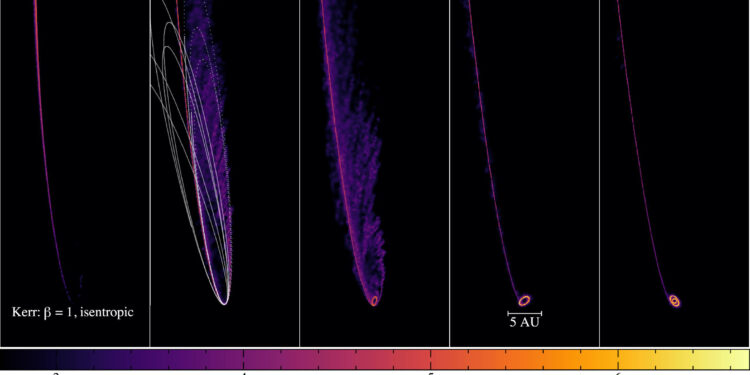Formation of a disk in an isentropic simulation (effective radiative cooling) with a rotating black hole (a = 0.99, θ = 60°). The disk in this case forms after 90 days and undergoes differential precession, which “rips” the disk into independent rings. Credit: Letters from the Astrophysical Journal (2024). DOI: 10.3847/2041-8213/ad6862
Astronomers from Monash University have contributed to a breakthrough in understanding the dramatic fate of stars that get too close to supermassive black holes at the centres of galaxies.
Using innovative simulations, an international research team, led by Professor Daniel Price and former student David Liptai from the School of Physics and Astronomy, has captured the complex process by which these stars are torn apart and consumed by black holes, providing new insights into the mysterious optical and UV emissions observed during these catastrophic events.
“This is the first self-consistent simulation of a star being disrupted by a supermassive black hole, followed by the evolution of the resulting debris over the course of a year,” Professor Price said.
“Our simulations provide a new perspective on the final moments of stars near supermassive black holes,” he said.
“By capturing the full evolution of the debris, we can try to connect the simulations to the growing number of observed star-destruction events identified through telescope surveys.”
The study, published in Letters from the Astrophysical Journalconstitutes a significant advance in astrophysics, opening new avenues of research into the behavior of matter in extreme gravitational fields and the life cycles of stars and black holes.
When a star passes too close to a supermassive black hole, intense gravitational forces rip it apart in a process known as a tidal disruption event (TDE). The debris from the star forms a current that eventually feeds the black hole. The debris from the star forms a swirling disk around the black hole, which emits intense radiation across the electromagnetic spectrum. However, many aspects of TDEs remain poorly understood.
The new simulations show that this debris forms an asymmetric bubble around the black hole, reworking the energy and producing the observed light curves with lower temperatures, lower luminosities and gas speeds of 10,000 to 20,000 km/s.
“The study helps explain several puzzling properties of the observed TDEs,” said Professor Price. “A good analogy is the human body: when we eat lunch, our body temperature doesn’t change much. This is because we convert the energy from the lunch back into infrared wavelengths.”
“A TDE is similar; we don’t typically see the stomach of the black hole ingesting gas because it is choked by matter that re-emits at optical wavelengths. Our simulations show how this choking occurs.”
Disk formation in the core of the envelope when an adiabatic simulation is continued with efficient radiative cooling. We resumed an adiabatic calculation 1 year after the rupture assuming an isentropic evolution. Credit: Letters from the Astrophysical Journal (2024). DOI: 10.3847/2041-8213/ad6862
Other mysteries explained by the new simulations include:
- Why tidal disruption events are observed at optical wavelengths rather than X-ray wavelengths, where one would expect the X-rays to come from accretion onto a supermassive black hole.
- Why the observed temperatures are consistent with the photosphere of a star rather than the expected hot accretion disk.
- Why observed star-shredding events are weaker than expected from models of black holes efficiently eating matter.
- Why the spectra of observed events show that matter is expanding towards us at a few percent of the speed of light (10 to 20,000 km/s).
The research team used the advanced smoothed particle hydrodynamics code Phantom, which incorporates general relativistic effects to accurately simulate the dynamics of the star and debris. This level of detail is essential to capture the complex interactions and energy dissipation processes that occur during and after stellar decay.
“The results confirm the theoretical existence of Eddington envelopes, which act as a reprocessing layer for the emitted energy, explaining the optical and ultraviolet emission observed during TDEs,” said Professor Price.
“This model also offers a potential explanation for the observed differences in X-ray and optical light curves during these events, suggesting that varying viewing angles could explain these discrepancies.”
More information:
Daniel J. Price et al., Eddington envelopes: the fate of stars in parabolic orbits perturbed by supermassive black holes, Letters from the Astrophysical Journal (2024). DOI: 10.3847/2041-8213/ad6862
Provided by Monash University
Quote: New simulations shed light on stellar destruction by supermassive black holes (2024, August 20) retrieved August 20, 2024 from
This document is subject to copyright. Apart from any fair dealing for the purpose of private study or research, no part may be reproduced without written permission. The content is provided for informational purposes only.



